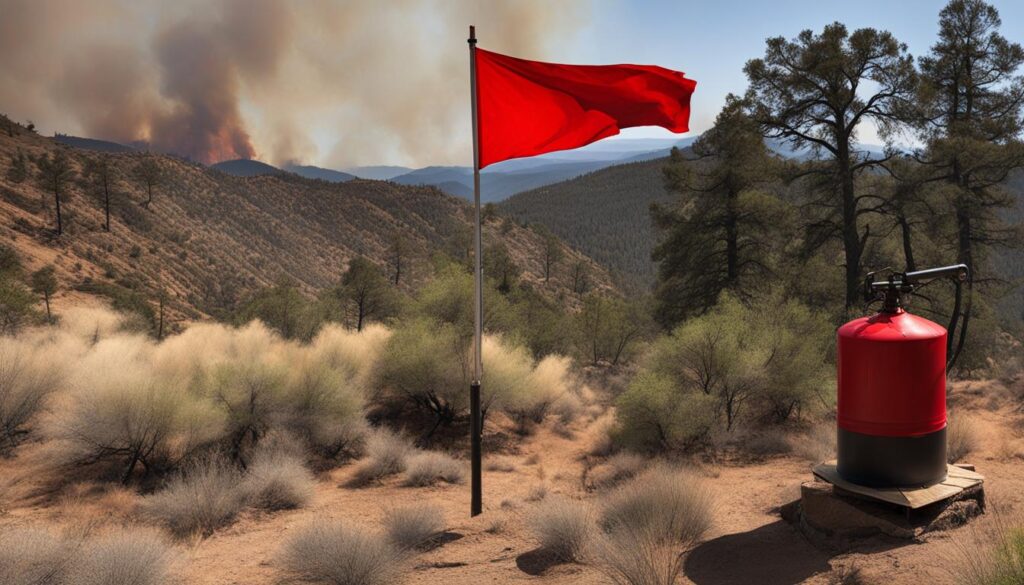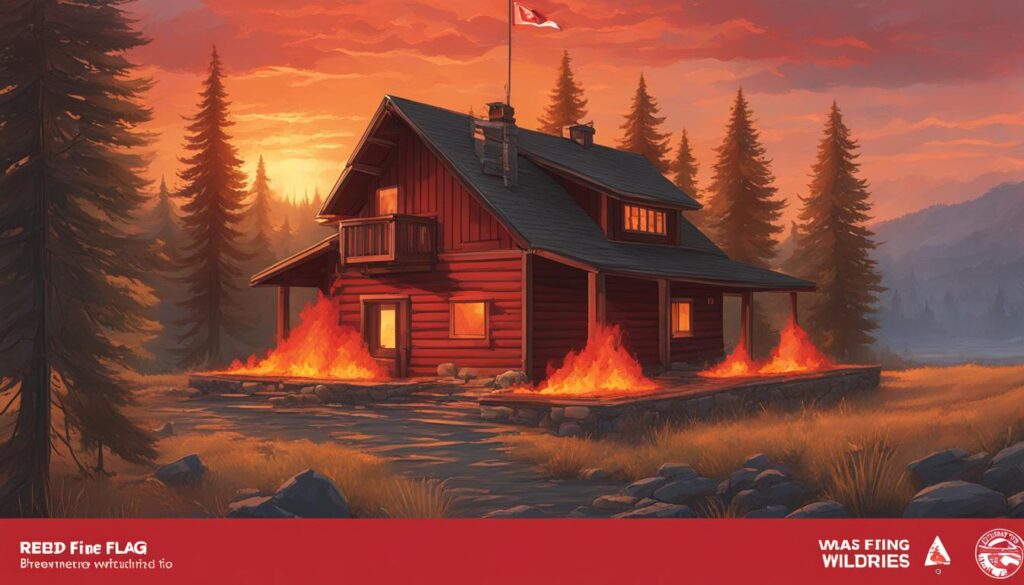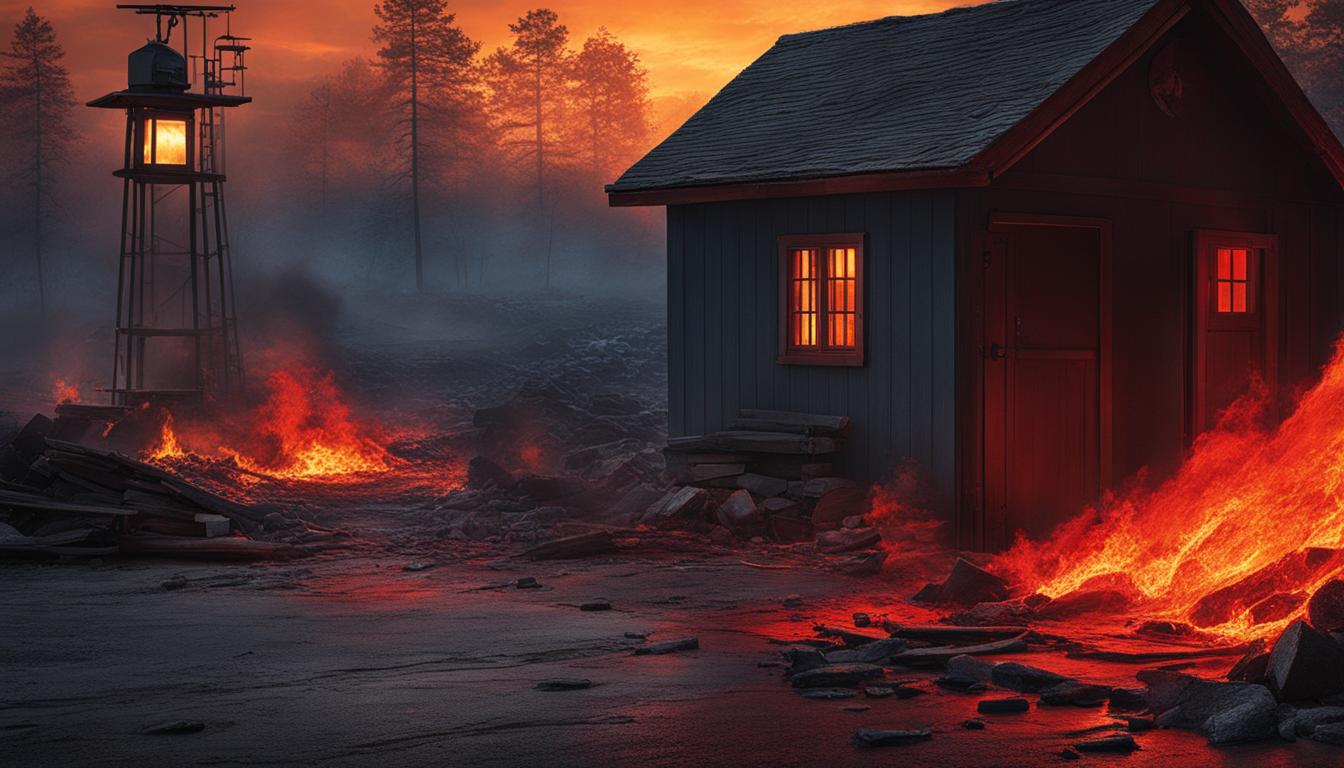In areas prone to wildfires, staying informed about fire weather conditions is crucial for the safety of individuals and communities. Two important warnings issued by the National Weather Service are Fire Weather Watches and Red Flag Warnings. While both indicate increased fire danger, there are key differences between the two.
A Fire Weather Watch is issued up to 72 hours before the expected critical fire weather conditions. It serves as an alert to land and fire managers to be prepared. On the other hand, a Red Flag Warning is a more urgent warning issued when the conditions for extreme fire danger are expected to occur within the next 24 hours. During a Red Flag Warning, it is important for people to take extra precautions and be ready to respond to any fire incidents.
Understanding the difference between Fire Weather Watches and Red Flag Warnings is essential for fire weather safety. By closely monitoring these warnings and taking appropriate measures, individuals and communities can minimize the risk of wildfires and protect lives and property.
Key Takeaways:
- A Fire Weather Watch is issued up to 72 hours before expected critical fire weather conditions.
- A Red Flag Warning is a more urgent warning issued when extreme fire danger conditions are expected within the next 24 hours.
- Fire Weather Watches serve as a heads-up for preparation, while Red Flag Warnings require immediate action.
- Monitoring fire weather forecasts and following wildfire prevention tips are crucial during these warnings.
- Proper response during a Red Flag Warning includes avoiding activities that could ignite fires and staying informed about evacuation orders.
Criteria for Fire Weather Watch and Red Flag Warning
When it comes to fire weather safety, understanding the criteria for issuing a Fire Weather Watch or Red Flag Warning is crucial. These warnings are issued by National Weather Service (NWS) offices and are based on specific criteria that assess the potential for extreme fire danger.
Fire Risk Assessment: The criteria for issuing a Fire Weather Watch or Red Flag Warning vary by location and are established by each NWS office. Some common criteria include sustained winds of 20 mph or higher, afternoon relative humidity below 25%, and low fuel moisture levels. Fuel moisture refers to the amount of water held by vegetation and is an important factor in determining fire risk.
Fire Weather Conditions: Monitoring these criteria allows the NWS to assess the potential for dangerous fire weather conditions. By analyzing factors such as wind speed, humidity, and fuel moisture levels, the NWS can issue timely warnings to land and fire managers, enabling them to take appropriate measures to prevent and mitigate wildfires.
| Criteria | Fire Weather Watch | Red Flag Warning |
|---|---|---|
| Sustained Winds | 20 mph or higher | 20 mph or higher |
| Relative Humidity | Below 25% | Below 25% |
| Fuel Moisture Levels | Low | Low |
Note: The above table illustrates some common criteria for Fire Weather Watch and Red Flag Warning. Please note that the specific criteria may vary by location and NWS office.
Red Flag Warning vs Fire Weather Watch
A Fire Weather Watch and a Red Flag Warning both indicate increased fire danger, but they have different implications. A Fire Weather Watch is a preliminary alert issued when the conditions for extreme fire danger are expected to occur within the next 72 hours. It serves as a heads-up for land and fire managers to be prepared. On the other hand, a Red Flag Warning is a more urgent warning issued when the conditions for extreme fire danger are expected to occur within the next 24 hours. During a Red Flag Warning, people are advised to take extra precautions to prevent wildfires and be prepared to respond to any fire incidents.
When a Fire Weather Watch is issued, it is important for land and fire managers to closely monitor the weather conditions and fuel moisture levels. This allows them to assess the potential severity of fire danger and take appropriate actions, such as increasing staffing levels and pre-positioning resources. It also serves as a reminder for individuals and communities to review their wildfire prevention plans and make necessary preparations.
During a Red Flag Warning, it is crucial for everyone to be aware of the heightened fire danger and take immediate action to prevent wildfires. This includes avoiding any activities that could ignite fires, such as outdoor burning or using fireworks. People should also be vigilant in reporting any signs of smoke or fire and follow evacuation orders if issued. By following proper wildfire prevention techniques and staying informed about fire weather advisories, we can all contribute to reducing the risk of wildfires and protecting lives and property.
Wildfire Prevention Tips:
- Clear leaves and other debris from roofs, gutters, and decks.
- Trim trees and remove dead branches to create a firebreak.
- Maintain a defensible space around your home by keeping vegetation well-watered and at a safe distance.
- Avoid parking vehicles or heavy equipment on dry grass.
- Properly dispose of cigarette butts and other flammable materials.
- Follow local burn bans and regulations.
Environmental Factors for Red Flag Warning
Several environmental factors contribute to the issuance of a Red Flag Warning. These factors include high temperatures, very low humidity, strong winds, dry thunderstorms, lightning, dry cold fronts, and long-term drought. When these conditions occur together, they create an environment that is conducive to dangerous fires. Monitoring these environmental factors allows the National Weather Service to accurately assess fire risk and issue timely warnings to the public.
| Environmental Factor | Impact |
|---|---|
| High temperatures | Increase evaporation, drying out vegetation and creating a potential fire fuel |
| Very low humidity | Reduces moisture content in vegetation, making it more susceptible to catching fire |
| Strong winds | Quickly spread fires, making them harder to control |
| Dry thunderstorms | May produce lightning without significant rainfall, increasing the risk of fire ignition |
| Lightning | Directly causes fires when strikes occur near flammable vegetation |
| Dry cold fronts | Bring dry, windy conditions that can rapidly spread fires |
| Long-term drought | Creates dry conditions, resulting in low fuel moisture and increased fire risk |
“During a Red Flag Warning, it is vital for individuals and communities to be aware of these environmental factors and take necessary precautions to prevent wildfires,” says John Smith, a fire safety expert. “By understanding the signs of fire danger and being prepared, we can reduce the impact of wildfires and protect lives and property.”
Monitoring fire weather conditions and staying informed about Red Flag Warnings can help communities prioritize fire prevention measures, such as implementing fire-safe landscaping practices, removing dead vegetation, and creating defensible space around homes. Public awareness campaigns and education on fire weather safety are crucial in preventing wildfires and minimizing their devastating effects.

Key Wildfire Danger Signs:
- Excessive heat and dry weather
- Low humidity levels
- Strong and gusty winds
- Presence of dry vegetation
- Reports of nearby fires or smoke
Geographic Distribution of Red Flag Warnings
Red Flag Warnings are important alerts issued to areas where extreme fire danger is expected. While these warnings are more commonly issued in western and southwestern states in the United States, their distribution can vary depending on weather patterns and local fire risk. In recent years, there has been an increase in the number of areas across the country experiencing Red Flag Warnings, raising widespread concerns about fire danger.
To assess the severity of fire weather conditions and issue appropriate advisories, local fire management agencies use a fire danger rating system. This system takes into account various factors, including fuel moisture, weather conditions, and the likelihood of fire ignition. By evaluating these factors, agencies can provide accurate assessments of fire risk and issue timely warnings to residents and land managers.
It is important for individuals and communities to stay informed about fire danger ratings and adhere to fire weather advisories. These warnings provide valuable information about the potential for wildfires and the actions that should be taken to minimize risk. By understanding the geographic distribution of Red Flag Warnings and the local fire danger rating system, communities can better prepare for and respond to fire weather conditions.
Table: Fire Danger Ratings and Actions
| Fire Danger Rating | Action |
|---|---|
| Low | No special action required. |
| Moderate | Be cautious with fire-related activities and follow local guidelines. |
| High | Avoid activities that could lead to fire ignition, such as outdoor burning or using fireworks. |
| Very High | Take extra precautions to prevent wildfires, such as creating defensible space around homes and maintaining a fire-resistant landscape. |
| Extreme | Minimize outdoor activities and be prepared to evacuate if necessary. |
By understanding the geographic distribution of Red Flag Warnings and the fire danger ratings, individuals can make informed decisions and take appropriate measures to protect themselves and their communities during periods of elevated fire risk. It is crucial to stay updated on fire weather forecasts and follow the guidance provided by local fire management agencies to prevent wildfires and mitigate their impact.
Importance of Fire Weather Safety
Understanding the difference between a Fire Weather Watch and a Red Flag Warning is crucial for fire weather safety. When these warnings are issued, it is important for individuals and communities to take immediate action to prevent wildfires and protect lives and property. This can include following wildfire prevention tips, closely monitoring fire weather forecasts, staying informed about fire danger ratings, and being prepared to evacuate if necessary. By being proactive and taking appropriate measures, the risk of wildfires can be minimized.
Wildfire Prevention Tips:
- Clear leaves, debris, and flammable materials from your roof and gutters regularly.
- Keep a 30-foot clear space around your home by removing dead vegetation and trimming trees.
- Store firewood and other combustible materials at least 30 feet away from structures.
- Avoid parking vehicles or operating equipment on dry grass or brush.
- Properly dispose of cigarette butts in designated containers.
- Avoid outdoor burning, especially during periods of high fire danger.
Remember, fire weather conditions can change rapidly, so stay vigilant and be prepared to take action.
Monitoring fire weather forecasts and staying informed about fire danger ratings are essential for determining the level of risk and the necessary precautions. In areas with higher fire danger ratings, it is important to be extra cautious and follow any guidance or restrictions given by local authorities. Being prepared to evacuate if necessary and having an emergency plan in place can also help protect lives and property during periods of extreme fire weather conditions.

How to Respond to Red Flag Warnings
During a Red Flag Warning, it is crucial to respond promptly and take necessary precautions to ensure personal safety and minimize the potential for wildfires. Here are some important steps to follow:
- Avoid activities that could easily ignite fires, such as outdoor burning, using fireworks, or operating machinery that creates sparks.
- Be vigilant and report any signs of smoke or fire immediately to local authorities. Time plays a critical role in preventing wildfires from spreading.
- Stay updated on the latest fire danger rating and fire weather advisories. This information can be obtained from local news sources, National Weather Service bulletins, or fire management agencies.
- Follow evacuation orders if issued. It is important to have a plan in place and be prepared to evacuate quickly and safely.
- Create defensible space around your home. This involves clearing vegetation, leaves, and other flammable materials from the immediate vicinity of your property to reduce the risk of fire reaching your home.
- Maintain a fire-resistant landscape by choosing fire-resistant plants, properly spacing trees and shrubs, and regular maintenance of your property.
By following these wildfire prevention tips and responding appropriately to Red Flag Warnings, you can play a vital role in mitigating the risk of wildfires and protecting lives and property.
Remember, wildfire prevention is a collective effort, and everyone has a role to play in ensuring fire weather safety. Taking proactive measures and staying informed can make a significant difference in the fight against wildfires.
Stay prepared, stay vigilant, and together we can minimize the devastating impact of wildfires.
| Fire Danger Rating | Fire Weather Advisory | Wildfire Prevention Tips |
|---|---|---|
| Low | No warning | Clear dead leaves and debris from the roof |
| Moderate | Exercise caution | Properly dispose of cigarette butts |
| High | Heightened alert | Avoid outdoor burning |
| Very High | Increased risk | Keep flammable materials away from structures |
| Extreme | Extreme danger | Evacuate when instructed |

Conclusion
Understanding the difference between a Fire Weather Watch and a Red Flag Warning is crucial for wildfire safety. Both warnings indicate increased fire danger, but a Red Flag Warning is a more urgent warning issued when critical fire weather conditions are expected to occur within the next 24 hours.
By staying informed about fire weather forecasts, following wildfire prevention tips, and responding appropriately to Red Flag Warnings, individuals and communities can mitigate the risk of wildfires and protect lives and property. Fire weather safety should be a top priority, especially in areas prone to wildfires.
To ensure fire weather safety, it is important to follow wildfire prevention tips, such as creating defensible space around homes, maintaining a fire-resistant landscape, and avoiding activities that could ignite fires during Red Flag Warning conditions. Additionally, staying informed about fire danger ratings and being prepared to evacuate if necessary are essential steps to protect yourself and your community.
By taking proactive measures and being vigilant, we can all contribute to minimizing the risk of wildfires and safeguarding our environment and communities. Remember, fire weather safety is a shared responsibility, and together, we can make a difference.
FAQ
What is the difference between a Fire Weather Watch and a Red Flag Warning?
A Fire Weather Watch is issued up to 72 hours before expected critical fire weather conditions, while a Red Flag Warning is issued when the conditions are expected within the next 24 hours.
What criteria are considered when issuing a Fire Weather Watch or a Red Flag Warning?
The criteria vary by location but generally include sustained high winds, low relative humidity, and dry fuel moisture levels.
How are Red Flag Warnings and Fire Weather Watches used for fire weather safety?
A Fire Weather Watch serves as a heads-up for land and fire managers to be prepared, while a Red Flag Warning is a more urgent warning for people to take extra precautions and be prepared to respond to any fire incidents.
What environmental factors contribute to the issuance of Red Flag Warnings?
Factors include high temperatures, low humidity, strong winds, dry thunderstorms, lightning, dry cold fronts, and long-term drought.
Where are Red Flag Warnings typically issued?
Red Flag Warnings are typically issued in western and southwestern states in the United States, but the distribution can vary depending on weather patterns and local fire risk.
Why is understanding Fire Weather Watch and Red Flag Warning important for fire safety?
By staying informed, following prevention tips, and responding to warnings, individuals and communities can mitigate the risk of wildfires and protect lives and property.
How should individuals respond to Red Flag Warnings?
It is essential to avoid activities that could ignite fires, report signs of smoke or fire, and follow evacuation orders if issued. Maintaining fire-resistant landscapes can also help reduce the risk.
 Skip to main content
Skip to main content


